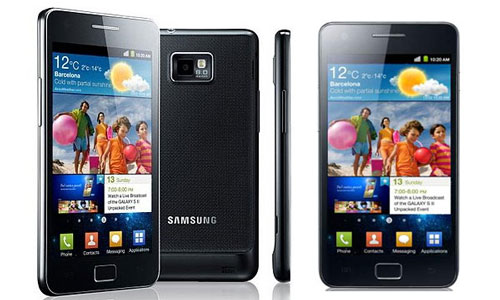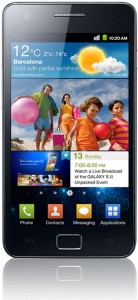
Samsung’s successor to the well-received Galaxy S is one of the first dual-core phones to make it to market, and it’s certainly set the bar high for the likes of the HTC Sensation, LG Optimus 2X and iPhone 5, all of which are expected later this year.
The most striking aspects of the S II are its physical dimensions and its screen. At a mere 8,49mm thick, the S II is one of the thinnest smartphones on the market and, at 116g, one of the lightest, too. The plastic chassis is in part to thank for it light weight, and although it doesn’t feel as sturdy as its aluminium-clad rivals, it doesn’t feel flimsy either. Moreover, one look at the 4,3-inch Super Amoled display and all quality worries evaporate.
At 480×800 pixels, the S II’s screen doesn’t offer the best pixel density on the market, but it’s a stunning display offering rich contrast, vibrant colours and incredibly forgiving viewing angles. In fact, it’s one of the best handset screens we’ve seen.
The only display-related problem comes in the form of the auto-brightness setting that seems to have a hard time judging ambient light and changes brightness settings seemingly at random on occasion.
The auto-brightness issue has supposedly been fixed with a software update, but despite having a Samsung user account and ensuring we were signed in we weren’t able to get the handset to update over the air. Also, the supplied software doesn’t yet support Mac. There is a beta version of Samsung’s Kies software available for Mac, but it isn’t supplied with the handset — another black mark against an otherwise superb device.
The S II feels really comfortable to hold and use, although those with small hands may find it too large. The rear cover is textured for a secure hold and dry hands during extended use and the volume switch and power button are located sufficiently high up the sides that accidental presses are unlikely.
Boasting a 1,2GHz dual-core processor, the S II is very responsive and can easily juggle a dozen applications simultaneously. Despite our best efforts, and running countless applications simultaneously, we couldn’t get it to crash.
The S II runs Android 2.3 Gingerbread out of the box and includes Samsung’s proprietary TouchWiz interface, which includes minor but pleasing features like the ability to swipe left on a contact’s name to send them an SMS or swipe right to call them. Typing is a pleasure on the S II, haptic feedback is instant and well implemented, and there is the option to use a traditional keypad layout in portrait mode for one-handed typing, a feature other phones often lack.

Overall, the user interface is great, which in fairness is thanks to Android more than Samsung. My only gripe is that Samsung sets the default home screen to the first of seven, rather than allowing the user to set their own. The benefit of being able to set pages two to six of the seven to the home screen is that two pages, rather than one, are then a single swipe away. Although, as pinching any home page zooms out to a grid of all seven this is a minor complaint.
Like its Android brethren, the S II is highly customisable and its menus are intuitive, although unfortunately there is no option to rearrange applications alphabetically or by install date.
Aside from the volume toggle switch and the power/lock switch the only button on the S II is the home button in the centre of the bottom of display. Two capacitive touch buttons, a menu/option button on the left and a back button on the right, flank the home button.
Double-pressing the home button enables Samsung’s Vlingo voice recognition software, but on the whole it’s more frustrating than useful. Thankfully, the S II has enough redeeming qualities to make this a minor failing. Voice functionality is certainly improving, but it’s got some way to go before it’ll be accurate enough to become truly useful.
Curiously, the S II doesn’t include a Facebook or Twitter application out of the box, but this is easily remedied via the Android Market. It does, however, include support for gestures, the most useful of which is the ability to turn the phone over during an incoming call to silence it and stop it from vibrating and the ability to zoom an image or browser page by pressing both thumbs to the screen and tilting it forwards or backwards.
The built-in Allshare application supports media streaming to DNLA-enabled devices, and allows Windows users to access phone content wirelessly and effortlessly.
Available with 16GB or 32GB of internal storage and supplied with an 8GB microSD card (expandable to 32GB), the S II offers generous storage capacity. Considering the 8-megapixel camera with LED flash and support for 1080p video at 30fps, this is a good move by Samsung.
The S II also has a 2-megapixel secondary camera, which is in line with its competition and better than the iPhone 4’s. The only thing that Samsung’s S II lacks in the camera department is a dedicated shutter release button.
Despite its good looks and powerful innards, the S II isn’t perfect. Battery technology continues to fail to keep up with the demands of energy-hungry smartphones. With its enormous screen, the S II seems hungrier than most, and even ensuring all connectivity options were turned off when not in use the S II only just lasts a day.
Samsung Galaxy S II official demo (via YouTube):
http://www.youtube.com/watch?v=4n2Kp4ekWNs
Also, Samsung has some peculiar ideas when it comes to socially acceptable ringtones and notification sounds. The default choices are universally awful and many are unpleasantly high-pitched. Samsung probably thinks of the tones as quirky. They’re not. They’re just rubbish.
Despite a couple of minor failings, the S II is an incredible device. It’s certainly a contender for the finest smartphone currently on the market. Some may find it a little too big, but that really comes down to personal preference. In terms of functionality, features and form factor it’s going to prove tricky to match and difficult to beat. — Craig Wilson, TechCentral
- Subscribe to our free daily newsletter
- Follow us on Twitter or on Facebook




